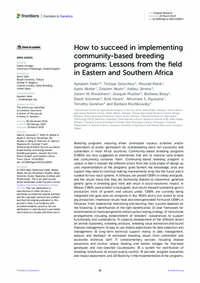How to succeed in implementing community-based breeding programs: Lessons from the field in Eastern and Southern Africa

Authors:
Breeding programs involving either centralized nucleus schemes and/or importation of exotic germplasm for crossbreeding were not successful and sustainable in most Africa countries. Community-based breeding programs (CBBPs) are now suggested as alternatives that aim to improve local breeds and concurrently conserve them. Community-based breeding program is unique in that it involves the different actors from the initial phase of design up until implementation of the programs, gives farmers the knowledge, skills and support they need to continue making improvements long into the future and is suitable for low input systems. In Ethiopia, we piloted CBBPs in sheep and goats, and the results show that they are technically feasible to implement, generate genetic gains in breeding goal traits and result in socio-economic impact. In Malawi, CBBPs were piloted in local goats, and results showed substantial gain in production traits of growth and carcass yields. CBBPs are currently being integrated into goat pass-on programs in few NGOs and is out-scaled to local pig production. Impressive results have also been generated from pilot CBBPs in Tanzania. From experiential monitoring and learning, their success depends on the following: 1) identification of the right beneficiaries; 2) clear framework for dissemination of improved genetics and an up/out scaling strategy; 3) institutional arrangements including establishment of breeders’ cooperatives to support functionality and sustainability; 4) capacity development of the different actors on animal husbandry, breeding practices, breeding value estimation and sound financial management; 5) easy to use mobile applications for data collection and management; 6) long-term technical support mainly in data management, analysis and feedback of estimated breeding values from committed and accessible technical staff; 7) complementary services including disease prevention and control, proper feeding, and market linkages for improved genotypes and non-selected counterparts; 8) a system for certification of breeding rams/bucks to ensure quality control; 9) periodic program evaluation and impact assessment; and 10) flexibility in the implementation of the programs. Lessons relating to technical, institutional, community dynamics and the innovative approaches followed are discussed.
